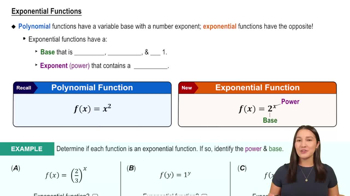Identify the open intervals on which the function is increasing or decreasing.
Table of contents
- 0. Functions7h 54m
- Introduction to Functions16m
- Piecewise Functions10m
- Properties of Functions9m
- Common Functions1h 8m
- Transformations5m
- Combining Functions27m
- Exponent rules32m
- Exponential Functions28m
- Logarithmic Functions24m
- Properties of Logarithms36m
- Exponential & Logarithmic Equations35m
- Introduction to Trigonometric Functions38m
- Graphs of Trigonometric Functions44m
- Trigonometric Identities47m
- Inverse Trigonometric Functions48m
- 1. Limits and Continuity2h 2m
- 2. Intro to Derivatives1h 33m
- 3. Techniques of Differentiation3h 18m
- 4. Applications of Derivatives2h 38m
- 5. Graphical Applications of Derivatives6h 2m
- 6. Derivatives of Inverse, Exponential, & Logarithmic Functions2h 37m
- 7. Antiderivatives & Indefinite Integrals1h 26m
- 8. Definite Integrals4h 44m
- 9. Graphical Applications of Integrals2h 27m
- 10. Physics Applications of Integrals 3h 16m
- 11. Integrals of Inverse, Exponential, & Logarithmic Functions2h 31m
- 12. Techniques of Integration7h 41m
- 13. Intro to Differential Equations2h 55m
- 14. Sequences & Series5h 36m
- 15. Power Series2h 19m
- 16. Parametric Equations & Polar Coordinates7h 58m
6. Derivatives of Inverse, Exponential, & Logarithmic Functions
Derivatives of Exponential & Logarithmic Functions
Problem 3.9.44
Textbook Question
15–48. Derivatives Find the derivative of the following functions.
P = 40/1+2^-t
 Verified step by step guidance
Verified step by step guidance1
Step 1: Identify the function P(t) = \frac{40}{1 + 2^{-t}}. This is a rational function where the numerator is a constant and the denominator is a function of t.
Step 2: Apply the quotient rule for derivatives, which states that if you have a function \frac{u(t)}{v(t)}, its derivative is \frac{u'(t)v(t) - u(t)v'(t)}{(v(t))^2}. Here, u(t) = 40 and v(t) = 1 + 2^{-t}.
Step 3: Calculate u'(t). Since u(t) = 40, which is a constant, its derivative u'(t) = 0.
Step 4: Calculate v'(t). The function v(t) = 1 + 2^{-t} involves an exponential term. The derivative of 2^{-t} with respect to t is -2^{-t} \ln(2), using the chain rule.
Step 5: Substitute u'(t), u(t), v(t), and v'(t) into the quotient rule formula: \frac{0 \cdot (1 + 2^{-t}) - 40 \cdot (-2^{-t} \ln(2))}{(1 + 2^{-t})^2}. Simplify the expression to find the derivative of P(t).
 Verified video answer for a similar problem:
Verified video answer for a similar problem:This video solution was recommended by our tutors as helpful for the problem above
Video duration:
3mPlay a video:
Was this helpful?
Key Concepts
Here are the essential concepts you must grasp in order to answer the question correctly.
Derivatives
A derivative represents the rate at which a function changes at any given point. It is a fundamental concept in calculus that measures how a function's output value changes as its input value changes. The derivative can be interpreted as the slope of the tangent line to the curve of the function at a specific point.
Recommended video:

Derivatives
Chain Rule
The chain rule is a formula for computing the derivative of a composite function. If a function is composed of two or more functions, the chain rule allows us to differentiate it by multiplying the derivative of the outer function by the derivative of the inner function. This is particularly useful when dealing with functions that include exponentials or other transformations.
Recommended video:

Intro to the Chain Rule
Exponential Functions
Exponential functions are mathematical functions of the form f(t) = a * b^t, where 'a' is a constant, 'b' is the base of the exponential, and 't' is the exponent. These functions are characterized by their rapid growth or decay and are commonly encountered in calculus. Understanding their properties is essential for differentiating functions that involve exponential terms.
Recommended video:

Exponential Functions

 4:50m
4:50mWatch next
Master Derivatives of General Exponential Functions with a bite sized video explanation from Patrick
Start learningRelated Videos
Related Practice
Multiple Choice
